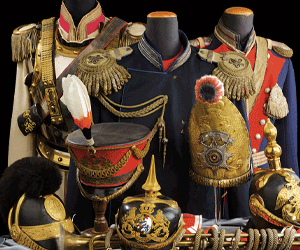German Police Officer's Sword by P. Weyersberg & Co.
SKU: 52.GOR.04.02.01.005
Estimated market value:


Estimated market value:
Attributes
History
During the Third Reich, an effort was made to unite all of Germany’s disparate provincial police forces and agencies into a single cohesive national unit. To attain this goal, Reichsführer-SS Heinrich Himmler was named Chief of the German Police in the Ministry of the Interior in June 1936. That same month, Himmler implemented new standardized uniforms, headgear, and insignia. The uniforms worn prior to Himmler’s appointment were often navy blue, particularly in what had been Prussia. The new uniforms were green, in a shade that was then dubbed “Police green”.
The German Police were divided into two main units, the Ordnungspolizei (Orps or Regular Police) and the Sicherheitspolizei (Secret Police); the Ordnungspolizei were unofficially called the green police (Grüne Polizei) as a result of their uniform colour. The Sicherheitspolizei were made up of two main organizations, the Gestapo and the Kriminalpolizei (Criminal Investigation Police). At the beginning of the Second World War, the Sicherheitspolizei were brought under the auspices of the Reich Main Security Office.
The swords worn by members of the German Police did not have a standardized design until 1936. The German Police Sword was worn by Officers and Non-Commissioned Officers (NCOs) within the German Police when they wore their mess dress, service uniforms, or parade uniform.
The general design of the Officer and NCO swords are very similar. The main differences between the two sword versions are in the shape of the pommel button and the use of aluminum wire between the grip grooves.
The handle of the sword is made up of the pommel, the grip, the knuckle bow, and the crossguard. The pommel design varies depending on the wearer’s rank. For Officers, the pommel has a large oblong button with corrugated edges, while for NCOs, the pommel button has a flat oval shape without corrugated edges. The grip is composed of black wood or plastic with horizontal groves. A silver-coloured (silvered aluminum) police eagle insignia should be mounted on the grip obverse. On Officer swords, aluminum wire is wrapped within the grip grooves. The knuckle bow has a “D” shape. The crossguard has an extending arm/quillon, and there is often a leather blade washer below the crossguard. Also, the Officer swords feature a mount at the bottom of the grip, while the NCO swords do not.
The blade is straight and composed of nickel-plated steel. The obverse and reverse of the blade ricasso generally feature acid etched manufacturer marks. The manufacturer’s logo/trademark may be featured on the obverse, while the full name and location of the manufacturer may be on the reverse. Also, presentation blades may feature an ornate inscription on the blade celebrating a specific event or person.
The scabbard is made from sheet steel painted black. At the top of the scabbard there is a silver-coloured mouthpiece and throat piece/locket. The throat piece/locket features ornate geometric designs. Below the throat is a lacquered iron band with a suspension ring that facilitates the sword’s attachment to a saddle or belt. At the bottom of the scabbard there is a crest.
The silver, red, and black portapee/sword knot was permitted for wear with the Police Swords.

Versions
$800 USD
Blade: 850mm; Sword in Scabbard: 935mm
Paul Weyersberg & Co., Solingen
Tiger, Solingen (3320)


Comments
Sign in to comment and reply.


Scroll Top